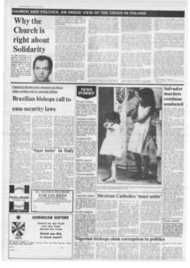Page 5, 6th August 1982
Page 5

Report an error
Noticed an error on this page?If you've noticed an error in this article please click here to report it.
Tags
Share
Related articles
Catholics And Oxford
Greyfriars To Close Despite Plea From The Vatican
Higher Education A Special Feature
Oxford College
On The Other Side, The Statutes Of The University Of
Catholicism puts down new roots in an ancient setting
I WRITE from St Benet's Hall, which is one of the five Oxford Private Halls. Under a statute of 1918 the Permanent Private Halls were licensed to accept academic students on a nonprofit basis under a Master who is required to be an Oxford MA. The students are full members of the University, partaking in its privileges and admissible to its degrees in the same way as the students of the Colleges.
Of the five Halls the Jesuit Campion Hall was founded in 1896, this Benedictine Hall (from Ampleforth Abbey) was founded in 1897, and the Franciscan Greyfriars was founded in 1910: the other two Halls also have a religious basis. There is nothing comparable in Cambridge, where religious, while they may live in their own houses of study, are expected to affiliate with a College as members thereof. Currently, Campion Hall has 5 arts undergraduates and 7 arts postgraduates; Greyfriars 18 and 2; St Benet's Hall 29 and 6, some 67 in all (which scarcely amounts to a small College).
The foundation dates are interesting: Cardinal Manning, who was an implacable champion of Catholics being educated in a Catholic World and not at Oxford or Cambridge, died in 1892; and at once the Catholic communities took steps to return to the great universities. Truth is found, strengthened and guarded not in a ghetto but in the open forum in the presence of one's peers of whatever persuasion, once one has acquired the judgment to discern it (and indeed that is acquired by putting it to the test).
These Halls, in virtue of limited resource, have to cut their cloth and concentrate on arts subjects: for us at St Benet's, the mainstay are English and History, Law and PPE, Languages, Geography and Theology. Besides taking monks and priests, we take on 3 year degree courses boys from
the Benedictine schools (Downside, Ampleforth, Worth, etc.), other Catholic schools and then other schools that provide students willing to fit into Our life and community.
They relate both to the Master and monks of the Hall and to the Catholic Chaplaincy (The Old Palace, opposite Christ Church) with its two chaplains, one an Oriel D.Phil. in Newman studies. The Chaplaincy has a constant care of some 700 Catholic students at various levels, together with senior members of the University and their families: the Sunday homilies, often given by visiting prelates and professorial priests, attract large numbers in term time. In the course of each term the chaplains bring the Mass on weekday evenings to virtually all the College chapels, relations with the Anglican College chaplains being very convenable. Such expeditions as an Oxford/Lourdes Pilgrimage (attracting some 50 annually) take place out of term. All the time, there is a considerable life (lectures, discussions, St Vincent de Paul visitation work, etc) emanating from The Old Palace, besides a groundswell of club hospitality there.
Perhaps a word about Oxford theology should round off this cameo. There is a Dominican presence, Black friars, adjacent to St Benet's Hall — separated indeed by the Baptist Private Hall of Regents Park (58 arts undergraduates, 15 graduates) and the High Anglican Pusey. House (which now shares with the new St Cross College). The Dominicans are not directly of the University, but do provide towards its theology from its lecture and tutorial resources; it being the main study house for the Order of Preachers in England, issuing its own STL.
There are likewise various Anglican theological colleges, such as Wycliffe Hall or St Stephen's House, which provide some 30 theological students
and make appropriate contributions. Thoughout the university, which provides 8 professors — Regius, Lady Margaret, and so forth; Scripture, Divinity, Pastoral Theology, and so forth — and an array of lecturers (many of them College chaplains), the number annually of those reading theology art degrees has risen from below 50 in 1971 to above 70 in 1979 and is now settled near 70, there being
nearly 200 theology undergraduates in residence, plus postgraduates (with over 40 out of residence).
As well as them, there are some 45 undergraduates reading Philosophy and Theology, with a more general support coming from the Philosophy lecturers. To top up, there are the formal University sermons and Preachers, notably the Bampton Lectures (8 divinity lecture/sermons) and the Sarum Lectures ("theological lectures in support of Christian faith") alternate years, usually issuing in a book.
blog comments powered by Disqus











